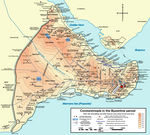Istanbul Railway Museum

The Istanbul Railway Museum (Turkish: İstanbul Demiryolu Müzesi) is a railway museum situated within the historic İstanbul Sirkeci Terminal at Sirkeci neighborhood of Fatih district in Istanbul, Turkey. Opened on September 23, 2005, the museum is owned and operated by the Turkish State Railways (TCDD).In the museum, which is housed in the 1888-built and 1890-opened railway terminal, around 300 historical items are on display. The exhibits of the museum covering an area of 145 m2 (1,560 sq ft) include parts of the trains and the railway stations, photographs, and related documents. A few of these are furniture and silver services used in dining cars, station office equipment, the driver cab of an electric suburban train, manufacturer plates of some historic TCDD rolling stock, warning plates, and a station's clock and bell.It was reported that 52,774 people, among them 31,153 foreign tourists, visited the museum in 2006.
Excerpt from the Wikipedia article Istanbul Railway Museum (License: CC BY-SA 3.0, Authors, Images).Istanbul Railway Museum
Vezir Camii Çıkmazı Sokağı, Istanbul
Geographical coordinates (GPS) Address Nearby Places Show on map
Geographical coordinates (GPS)
| Latitude | Longitude |
|---|---|
| N 41.0153 ° | E 28.9771 ° |
Address
İstanbul-Sirkeci
Vezir Camii Çıkmazı Sokağı
34110 Istanbul
Türkiye
Open on Google Maps








